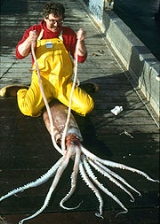
Robust Clubhook Squid
Encyclopedia
The Robust Clubhook Squid (Onykia robusta), often cited by the older name Moroteuthis robusta, is a species of squid
in the family Onychoteuthidae. It is the third largest species of squid after the Colossal Squid
and giant squid
; and largest of the genus Onykia
, reaching a mantle
length of 2 m (6.6 ft). The tentacular clubs are slender, containing 15–18 club hooks. Arms
of the species contain 50-60 suckers, and grow to 90–100% of the mantle length. It is found primarily in the boreal to temperate North Pacific.
 Some time before 1993, a large individual of O. robusta was photographed by Japan
Some time before 1993, a large individual of O. robusta was photographed by Japan
ese diver H. Kubota in shallow water off southern Japan
. In this image, the animal, which appears to be sick or dying, is shown with a diver, although the use of a wide-angle lens
exaggerates its size. A video of the same squid appears in a Japanese made-for-television film. The image was published in the 1993 book European Seashells by Guido T. Poppe and Yoshihiro Goto, where it was identified as Architeuthis dux, the giant squid
, and said to have been taken in the North Atlantic. If true, this image would represent the first known photograph of a live giant squid.
In The Search for the Giant Squid (1998), Richard Ellis
wrote of this photograph:
It would be more than a decade before the true first photographs of a live giant squid in the wild were taken on September 30, 2004.
Squid
Squid are cephalopods of the order Teuthida, which comprises around 300 species. Like all other cephalopods, squid have a distinct head, bilateral symmetry, a mantle, and arms. Squid, like cuttlefish, have eight arms arranged in pairs and two, usually longer, tentacles...
in the family Onychoteuthidae. It is the third largest species of squid after the Colossal Squid
Colossal Squid
The colossal squid , sometimes called the Antarctic or giant cranch squid, is believed to be the largest squid species in terms of mass. It is the only known member of the genus Mesonychoteuthis...
and giant squid
Giant squid
The giant squid is a deep-ocean dwelling squid in the family Architeuthidae, represented by as many as eight species...
; and largest of the genus Onykia
Onykia
Onykia is a genus of squids in the family Onychoteuthidae. Due to similarities between the genera, several recent authors consider the genus Moroteuthis a junior synonym of Onykia. The type species is the Tropical Clubhook Squid ....
, reaching a mantle
Mantle (mollusc)
The mantle is a significant part of the anatomy of molluscs: it is the dorsal body wall which covers the visceral mass and usually protrudes in the form of flaps well beyond the visceral mass itself.In many, but by no means all, species of molluscs, the epidermis of the mantle secretes...
length of 2 m (6.6 ft). The tentacular clubs are slender, containing 15–18 club hooks. Arms
Cephalopod arm
A cephalopod arm is distinct from a tentacle, though the terms are often used interchangeably.Generally, cephalopod arms have suckers along most of their length, as opposed to tentacles, which have suckers only near their ends. Octopuses have eight arms and no tentacles, while squid and cuttlefish...
of the species contain 50-60 suckers, and grow to 90–100% of the mantle length. It is found primarily in the boreal to temperate North Pacific.
Confusion with Architeuthis

Japan
Japan is an island nation in East Asia. Located in the Pacific Ocean, it lies to the east of the Sea of Japan, China, North Korea, South Korea and Russia, stretching from the Sea of Okhotsk in the north to the East China Sea and Taiwan in the south...
ese diver H. Kubota in shallow water off southern Japan
Japan
Japan is an island nation in East Asia. Located in the Pacific Ocean, it lies to the east of the Sea of Japan, China, North Korea, South Korea and Russia, stretching from the Sea of Okhotsk in the north to the East China Sea and Taiwan in the south...
. In this image, the animal, which appears to be sick or dying, is shown with a diver, although the use of a wide-angle lens
Wide-angle lens
From a design perspective, a wide angle lens is one that projects a substantially larger image circle than would be typical for a standard design lens of the same focal length; this enables either large tilt & shift movements with a view camera, or lenses with wide fields of view.More informally,...
exaggerates its size. A video of the same squid appears in a Japanese made-for-television film. The image was published in the 1993 book European Seashells by Guido T. Poppe and Yoshihiro Goto, where it was identified as Architeuthis dux, the giant squid
Giant squid
The giant squid is a deep-ocean dwelling squid in the family Architeuthidae, represented by as many as eight species...
, and said to have been taken in the North Atlantic. If true, this image would represent the first known photograph of a live giant squid.
In The Search for the Giant Squid (1998), Richard Ellis
Richard Ellis (biologist)
Richard Ellis is an American marine biologist, author, and illustrator. He is a research associate in the American Museum of Natural History's division of paleontology, special adviser to the American Cetacean Society, and a member of the Explorers Club. He was U.S...
wrote of this photograph:
"For a moment, I thought that some obscure photograph had captured the most elusive image in natural history. Fortunately for those who have devoted their lives to searching for Architeuthis, this was only an aberration, a case of mistaken identity."
It would be more than a decade before the true first photographs of a live giant squid in the wild were taken on September 30, 2004.

